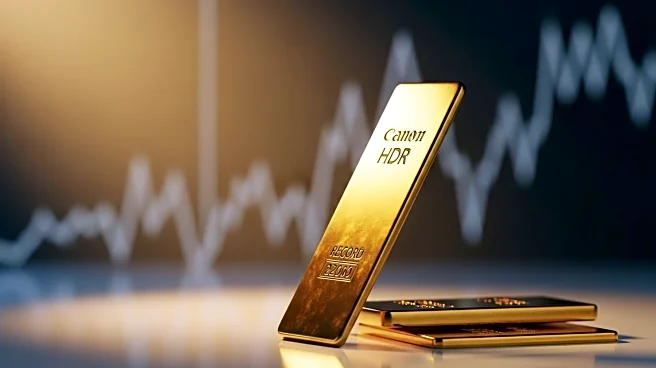What's Happening?
Gold prices have reached new record highs, driven by investor interest in the metal as a safe haven amid ongoing U.S.-China trade tensions and expectations of interest rate cuts by the Federal Reserve.
Spot gold increased by 0.8% to $4,242.65 per ounce, with U.S. gold futures for December delivery rising by 1.3% to $4,256.70. The metal has seen a significant gain of over 60% year-to-date, influenced by geopolitical tensions, central bank purchases, and robust ETF inflows. Analysts suggest that the trajectory of gold prices will depend on future rate cuts and developments in U.S.-China relations.
Why It's Important?
The surge in gold prices highlights the impact of geopolitical uncertainties and monetary policy expectations on financial markets. As investors seek safe-haven assets, the rising gold prices reflect concerns over the U.S.-China trade dispute and potential economic instability. The Federal Reserve's anticipated rate cuts could further influence gold's appeal, as lower interest rates typically benefit non-yielding assets like gold. This trend may affect various stakeholders, including investors, central banks, and industries reliant on gold, as they navigate the implications of fluctuating prices and economic conditions.
What's Next?
The future of gold prices will likely be shaped by the Federal Reserve's decisions on interest rates and the progression of U.S.-China trade negotiations. Traders are currently pricing in a 25 basis-point rate cut in October and another in December, with high probabilities. If no resolution is reached in the trade dispute, gold could potentially surpass the $5,000 per ounce mark. Additionally, the ongoing U.S. government shutdown may further impact economic data and market dynamics, adding another layer of uncertainty to the situation.
Beyond the Headlines
The rising gold prices also underscore broader economic concerns, such as de-dollarization and the search for alternative assets amid currency fluctuations. The geopolitical tensions and economic uncertainty may prompt shifts in investment strategies and influence global financial stability. As central banks continue to buy gold, the metal's role as a strategic reserve asset may gain prominence, affecting long-term economic policies and international relations.











